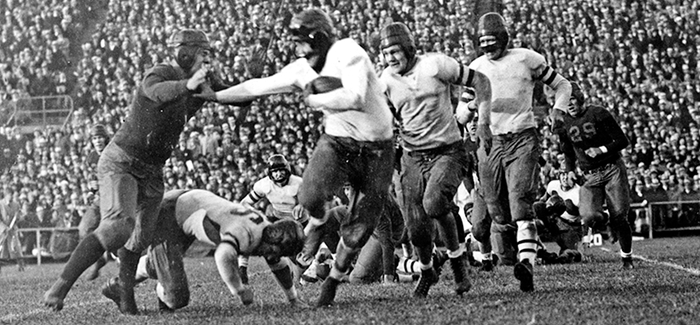
Long after Chicago left big-time football, Berwanger’s Heisman legacy endures. (Archival Photographic Files, apf4-00490, Special Collections Research Center, University of Chicago Library)
Jay Berwanger’s legacy endures, thanks in part to an award nobody had heard of when he won it.
Jay Berwanger, AB’36, needed a place to store his Heisman Trophy and his Aunt Gussie needed something to prop open the swinging door between her kitchen and dining room, so the arrangement worked out well. For 15 or 20 years that’s where the first Heisman statue stood, on Aunt Gussie’s floor, as if its stiff arm was designed to be a doorstop.
“Eventually Jay retrieved it and now it’s there at the Ratner Center on campus,” says Brian E. Cooper, author of First Heisman: The Life of Jay Berwanger (Crestwood Publishing, 2014). A few feet from where Cooper spoke, a new statue of Berwanger stood on a pedestal overlooking a high school football stadium in Dubuque, Iowa.
A September 22 ceremony featured the unveiling of Berwanger’s bronze likeness on a plaza at the entrance to the field where he played, now named for his high school coach, Wilbur Dalzell. Among the recollections floating around that afternoon, the “Heisman as doorstop” story captured Berwanger’s peculiar identification with what has become college football’s most prestigious prize.
As a senior halfback, he aspired to the Chicago Tribune’s Silver Football, given to “the most useful player to his team in the Big Ten.” He received the Silver Football and the Douglas Fairbanks Trophy, then the best-known honor for the nation’s most outstanding player. With those prizes already in tow, the telegram informing Berwanger that he had won the inaugural Downtown Athletic Club Trophy (later renamed the Heisman) interested him more for the expense-paid trip to New York it offered.
But the trophy and Berwanger’s reputation symbiotically increased in esteem over the years. As Archie Griffin, to date the only player to win the Heisman twice (for Ohio State in 1974 and ’75), told Cooper, “he was a classy individual and he lent a lot of credibility to the award.”
To this day, the award bestows credibility on Berwanger. It is the prize most associated with college football—“the best known individual award in American sports,” as First Heisman calls it—recognizable even to those who don’t follow the sport.
Even though Chicago has long since abandoned the trappings of big-time football, the legacy of the inaugural Heisman winner adds luster—and attracts talent—to the team. “He still helps our football program,” says associate athletic director Brian Baldea. “He’s a great recruiter.”
Widely recruited himself, Berwanger’s reputation preceded him to Chicago, but his humility belied his ability. Classmate Ernest Dix, AB’36, had never played the sport, Cooper says, “but decided as a freshman at Chicago that it might be a good idea to try to play Big Ten football.” Dix struggled just to master the equipment.
As he fussed with his shoulder pads, Berwanger came to his aid, essentially helping a novice teammate dress himself. A fast and long-lasting friendship developed. “For more than 70 years, they were friends,” Cooper says. “When I interviewed Ernie he talked about how modest Jay was about his accomplishments.”
Berwanger’s major athletic accomplishments ended at Chicago. In another notable “first,” he was the first pick in the first NFL draft, but the cost-benefit analysis of a professional football career didn’t add up. Although top players could earn up to $500 a game, they still had to supplement their income with other jobs in the off-season. As Berwanger noted, he could make that much money as an after-dinner speaker without the physical punishment.
There were rumors of a contract dispute with Chicago Bears owner George Halas, but Cooper says that Berwanger simply made him an offer he couldn’t accept. “Jay basically signaled to Halas by making an extremely high salary ‘demand’ that he wasn’t really that interested in pro football.”
Competing in the 1936 Olympics as a decathlete was a possibility and he considered leaving school after his senior football season to train. But the idea of the University’s star athlete—and student body president—taking an academic leave didn’t sit well with administrators. A vice president let Berwanger know that his scholarship would not be good if and when he returned. “We had a long discussion around Christmastime,” he said, “and we decided I should graduate.”
Never an Olympian, Berwanger played rugby and officiated college football games, moonlighting from his day job running a manufacturing business. He stayed in the Chicago area, raising his three children with his wife, Philomela, AB’38, AB’40, and returning to Hyde Park regularly for football games until his death in 2002 at age 88.
If most know him as the Heisman-winning halfback, it took a moment for his family to recognize the leather-helmeted ball carrier in the sculpture now on display in Dubuque. “We all looked at it and said, ‘That isn’t him,’ because we remember him as an older person,” his son Cuyler “Butch” Berwanger says. “But then you saw the pictures of him and, hey, that’s him, as a younger man.”
Sculptor Vala Ola’s rendering captures Berwanger in full stride, socks bunched around the ankles of his high-top cleats, one arm outstretched and head cocked backward as if he’s leaving defenders in his wake. In fact, the Berwanger statue bears a striking resemblance to Heisman itself, fitting given the association that was so rewarding for both the trophy and the man.
